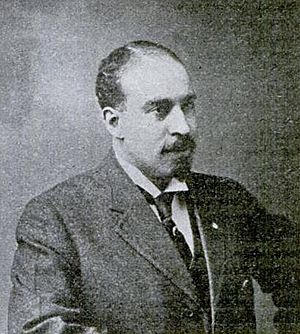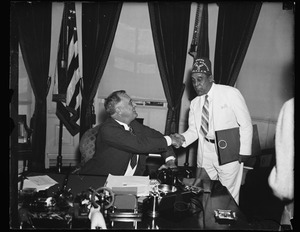William J. Thompkins facts for kids
Quick facts for kids
William J Thompkins
|
|
|---|---|
 |
|
| Recorder of Deeds for the District of Columbia | |
| In office March 1934 – 1944 |
|
| Preceded by | Jefferson Coege |
| Personal details | |
| Born | July 5, 1884 Jefferson City, Missouri |
| Died | August 4, 1944 (aged 60) Washington, D.C. |
| Political party | Democratic |
| Spouse | Jessie Embry |
| Alma mater | Lincoln University, University of Colorado, Howard University |
| Profession | Physician, Civil Servant |
William J. Thompkins (born July 5, 1884, died August 4, 1944) was an important doctor and health leader. He worked in Kansas City, Missouri. Later, he became the Recorder of Deeds for Washington, D.C. This was a high-level government job.
Thompkins first became well-known for fighting against unfair laws. These laws, called Jim Crow Laws, separated Black and White people. He challenged them in court in the early 1910s. He was a successful doctor. He also led a hospital and worked as an Assistant Commissioner of Health. He studied how living conditions affected a lung disease called tuberculosis in Black communities.
He was very active in politics. He led the National Negro Democratic Association. He helped with presidential campaigns from 1928 to 1940. In 1934, he got the job of Recorder of Deeds in Washington, D.C. This was the highest federal job given to an African American at that time. Famous leaders like Frederick Douglass had held this position before him.
Contents
About William J. Thompkins
William J. Thompkins was born on July 5, 1884, in Jefferson City, Missouri. He went to several universities. These included Lincoln University in Missouri, the University of Colorado, and Howard University School of Medicine. While at Lincoln University, he worked as a hotel bellboy to pay for his studies. In 1905, he trained at Freedmen's Hospital in Washington, D.C. This hospital helped formerly enslaved people and their families. After his training, he started his own medical practice in Kansas City, Missouri.
Thompkins married Jessie F. Embry. They had two daughters named Helen and Marian. William Thompkins passed away on August 4, 1944. He died at Freedmen's Hospital in Washington, D.C., after being sick for six months. His funeral was held at the Metropolitan AME Church.
His Work and Public Service
Health and Community Leadership
In the early 1910s, Thompkins was on a train. He was asked to leave a train car meant only for White people. This happened in Vinita, Oklahoma. Thompkins refused to leave. He was arrested and fined. He decided to challenge this unfair treatment in court. The case went to a high court, but he did not win money for damages. Still, his action showed his courage in fighting against segregation.
Thompkins was also a great public speaker. In 1911, he gave a speech about the progress of Black people in America. He talked about different ideas for how Black people could move forward. He believed that all paths to progress were important.
In 1928, he started a newspaper called the Kansas City American. It was the first Black Democratic newspaper in the city. He also tried to start a radio station for Black audiences in 1930. If he had succeeded, he would have been the first Black radio station owner. However, his request was turned down.
In 1914, Thompkins became the superintendent of the Old General Hospital (Negro department) in Kansas City. This hospital served Black and Mexican patients. He was the first Black man to hold this job. He did an amazing job, improving the hospital's rating significantly. He left in 1922.
After working in Oklahoma for a few years, he returned to Kansas City in 1926. He was appointed Assistant Commissioner of Health. He was the first Black man to hold this position too. In this role, Thompkins wrote an important study. It showed how poor housing conditions led to many cases of tuberculosis among Black people in Kansas City. His study was used as a guide by other health groups. His housing plan was even presented to President Herbert Hoover in 1930.
National Political Involvement
William Thompkins became involved in national politics in 1928. He supported the Democratic candidate for president, Alfred E. Smith. Thompkins was a leader of the National Colored Democratic Convention. In 1932, he was in charge of the Democratic campaign for Black voters in many states.
His hard work for the Democratic Party paid off. In March 1934, President Franklin D. Roosevelt appointed him as the Recorder of Deeds for Washington, D.C. This was a very important job.

In the 1936 election, Thompkins continued to be a key leader for Black Democrats. He was named an adviser on "colored affairs" to the Democratic Party Chairman. In 1939, Thompkins was part of a group that made history. They were the first Black people to eat in the private dining room of the Speaker of the House of Representatives.
Later, a law called the Hatch Act stopped federal employees from working on political campaigns. But Thompkins was given a special exception. He played a big role in the 1940 election for a senator in Missouri. He was a main leader for the Black division of Harry S. Truman's campaign.
In 1941, civil rights leaders planned a big march on Washington. They wanted to protest unfair treatment in the government. President Roosevelt worked to stop the march by making some changes. Thompkins and other Black government officials helped to prevent the march from happening.
Thompkins held many other important roles. He was the National Director of Health for the Colored Elks. He also started the National Negro Democratic Association. He was a trustee at Lincoln University and a vice president of the National Medical Association. He was also a member of several other important groups and held a reserve position in the Army Medical Corps.

